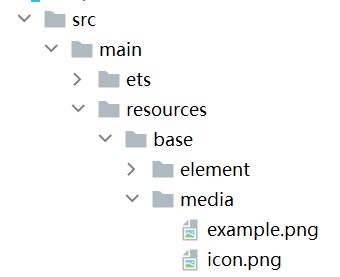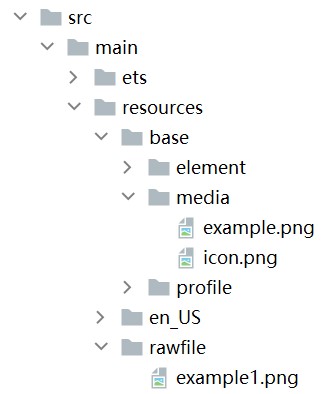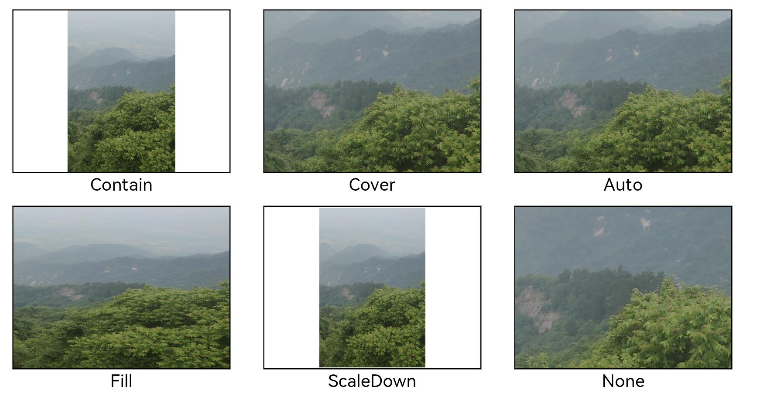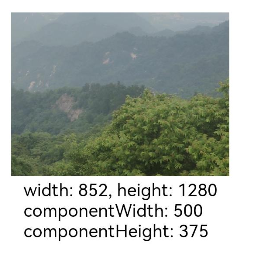Displaying Images
More often than not, you may need to display images in your application, for example, logos in buttons, online images, and local images. To do so, you need to use the <Image> component, which supports a wide range of image formats, including PNG, JPG, BMP, SVG, and GIF. For details, see Image.
You can call the API in the following format to create an image:
Image(src: string | Resource | media.PixelMap)
Obtains a local or online image from the image data source specified by src. For details about how to load the data source, see Loading Image Resources.
Loading Image Resources
The <Image> component supports two types of images: archived and pixel map.
Archived Type Data Source
Data sources of the archived type can be classified into local resources, online resources, Resource objects, media library data share resources, and Base64 resources.
-
Local resources Create a folder and place a local image in any position in the ets folder.
In the <Image> component, import the local image path to display the image. The root directory is the ets folder.
Image('images/view.jpg') .width(200) -
Online resources To use online images, first apply for the ohos.permission.INTERNET permission. For details, see Applying for Permissions. Under this scenario, the src parameter of the <Image> component is the URL of the online image.
Image('https://www.example.com/example.JPG') // Replace the URL with the actual URL. -
Resource objects Resource objects can be used to import images across bundles and modules. All images in the resources folder can be read and converted to the Resource objects through $r.
Figure 1 resources folder

API:
Image($r('app.media.icon'))You can also place the images in the rawfile folder.
Figure 2 rawfile folder

API:
Image($rawfile('snap'))
-
Media library data share resources To display images from the media library, use a path string that starts with datashare://.
- Call the API to obtain the image URL in the media library.
import picker from '@ohos.file.picker'; @Entry @Component struct Index { @State imgDatas: string[] = []; // Obtain the image URL set. getAllImg() { let photoPicker = new picker.PhotoViewPicker(); let result = new Array<string>(); try { let PhotoSelectOptions = new picker.PhotoSelectOptions(); PhotoSelectOptions.MIMEType = picker.PhotoViewMIMETypes.IMAGE_TYPE; PhotoSelectOptions.maxSelectNumber = 5; let photoPicker = new picker.PhotoViewPicker(); photoPicker.select(PhotoSelectOptions).then((PhotoSelectResult) => { this.imgDatas = PhotoSelectResult.photoUris; console.info('PhotoViewPicker.select successfully, PhotoSelectResult uri: ' + JSON.stringify(PhotoSelectResult)); }).catch((err) => { console.error(`PhotoViewPicker.select failed with. Code: ${err.code}, message: ${err.message}`); }); } catch (err) { console.error(`PhotoViewPicker failed with. Code: ${err.code}, message: ${err.message}`); } } // Call the preceding function in aboutToAppear to obtain the URLs of all images in the gallery and store the URLs in imgDatas. async aboutToAppear() { this.getAllImg(); } // Use the URL of imgDatas to load the image. build() { Column() { Grid() { ForEach(this.imgDatas, item => { GridItem() { Image(item) .width(200) } }, item => JSON.stringify(item)) } }.width('100%').height('100%') } } - Check the format of the URL obtained from the media library is as follows:
Image('datashare:///media/5') .width(200)
- Call the API to obtain the image URL in the media library.
-
base64
As shown above, the URL format is data:image/[png|jpeg|bmp|webp];base64,[base64 data], in which [base64 data] indicates Base64 string data.
Base64 strings are widely used on web pages for storing pixel data of images.
Pixel Map
A pixel map is a pixel image obtained after image decoding. For details, see Image Development. In the following example, the data returned by the loaded online image is decoded into a pixel map, which is then displayed on the <Image> component.
-
Create a PixelMap state variable.
@State image: PixelMap = undefined; -
Reference multimedia. Request an online image and implement transcoding to generate a pixel map.
- Reference the network access permission and media library permission.
import http from '@ohos.net.http'; import ResponseCode from '@ohos.net.http'; import image from '@ohos.multimedia.image'; - Enter the online image address.
http.createHttp().request("https://www.example.com/xxx.png", (error, data) => { if (error){ console.error(`http reqeust failed with. Code: ${error.code}, message: ${error.message}`); } else { } } ) - Transcode the data returned by the online image address to a pixel map.
let code = data.responseCode; if(ResponseCode.ResponseCode.OK === code) { let imageSource = image.createImageSource(data.result); let options = { alphaType: 0, // Alpha type. editable: false, // Whether the image is editable. pixelFormat: 3, // Pixel format. scaleMode: 1, // Scale mode. size: {height: 100, width: 100} } // Image size. imageSource.createPixelMap(options).then((pixelMap) => { this.image = pixelMap }) - Display the image.
Button ("Get Online Image") .onClick(() => { this.httpRequest() }) Image(this.image).height(100).width(100)
- Reference the network access permission and media library permission.
Display the vector image.
The <Image> component can display vector images in SVG format. The supported SVG labels are svg, rect, circle, ellipse, path, line, polyline, polygon, and animate.
You can use the fillColor attribute to change the fill color of an SVG image.
Image($r('app.media.cloud')).width(50)
.fillColor(Color.Blue)
Figure 3 Original image

Figure 4 SVG image after the fill color is set

Adding Attributes
Setting attributes for the <Image> component can spruce up the image with custom effects. The following are examples of common attributes. For details about all attributes, see Image.
Setting the Image Scale Mode
The objectFit attribute is used to scale an image to fit it into a container whose height and width are determined.
@Entry
@Component
struct MyComponent {
scroller: Scroller = new Scroller()
build() {
Scroll(this.scroller) {
Row() {
Image($r('app.media.img_2')).width(200).height(150)
.border({ width: 1 })
.objectFit(ImageFit.Contain).margin(15) // The image is scaled with its aspect ratio retained to fit within the display boundaries.
.overlay('Contain', { align: Alignment.Bottom, offset: { x: 0, y: 20 } })
Image($r('app.media.ic_img_2')).width(200).height(150)
.border({ width: 1 })
.objectFit(ImageFit.Cover).margin(15)
// The image is scaled with its aspect ratio retained for both sides to be greater than or equal to the display boundaries.
.overlay('Cover', { align: Alignment.Bottom, offset: { x: 0, y: 20 } })
Image($r('app.media.img_2')).width(200).height(150)
.border({ width: 1 })
// The image is scaled automatically to fit the display area.
.objectFit(ImageFit.Auto).margin(15)
.overlay('Auto', { align: Alignment.Bottom, offset: { x: 0, y: 20 } })
}
Row() {
Image($r('app.media.img_2')).width(200).height(150)
.border({ width: 1 })
.objectFit(ImageFit.Fill).margin(15)
// The image is scaled to fill the display area, and its aspect ratio is not retained.
.overlay('Fill', { align: Alignment.Bottom, offset: { x: 0, y: 20 } })
Image($r('app.media.img_2')).width(200).height(150)
.border({ width: 1 })
// The image content is displayed with its aspect ratio retained. The size is smaller than or equal to the original size.
.objectFit(ImageFit.ScaleDown).margin(15)
.overlay('ScaleDown', { align: Alignment.Bottom, offset: { x: 0, y: 20 } })
Image($r('app.media.img_2')).width(200).height(150)
.border({ width: 1 })
// The original size is retained.
.objectFit(ImageFit.None).margin(15)
.overlay('None', { align: Alignment.Bottom, offset: { x: 0, y: 20 } })
}
}
}
}

Synchronously Loading Images
Generally, the image loading process is performed asynchronously to avoid blocking the main thread and to streamline UI interaction. In certain cases, however, the image may flicker when refreshed. If this occurs, you can use the syncLoad attribute to load the image synchronously to avoid flickering. You are not advised to use this attribute when the image loading takes a long time. Otherwise, the page may fail to respond.
Image($r('app.media.icon'))
.syncLoad(true)
Adding Events
By binding the onComplete event to the <Image> component, you can obtain necessary information about the image after the image is successfully loaded. You can also bind the onError event to obtain error information when the image fails to be loaded.
@Entry
@Component
struct MyComponent {
@State widthValue: number = 0
@State heightValue: number = 0
@State componentWidth: number = 0
@State componentHeight: number = 0
build() {
Column() {
Row() {
Image($r('app.media.ic_img_2'))
.width(200)
.height(150)
.margin(15)
.onComplete((msg: {
width: number,
height: number,
componentWidth: number,
componentHeight: number
}) => {
this.widthValue = msg.width
this.heightValue = msg.height
this.componentWidth = msg.componentWidth
this.componentHeight = msg.componentHeight
})
// If the image fails to be obtained, print the result.
.onError(() => {
console.info('load image fail')
})
.overlay('\nwidth: ' + String(this.widthValue) + ', height: ' + String(this.heightValue) + '\ncomponentWidth: ' + String(this.componentWidth) + '\ncomponentHeight: ' + String(this.componentHeight), {
align: Alignment.Bottom,
offset: { x: 0, y: 60 }
})
}
}
}
}
